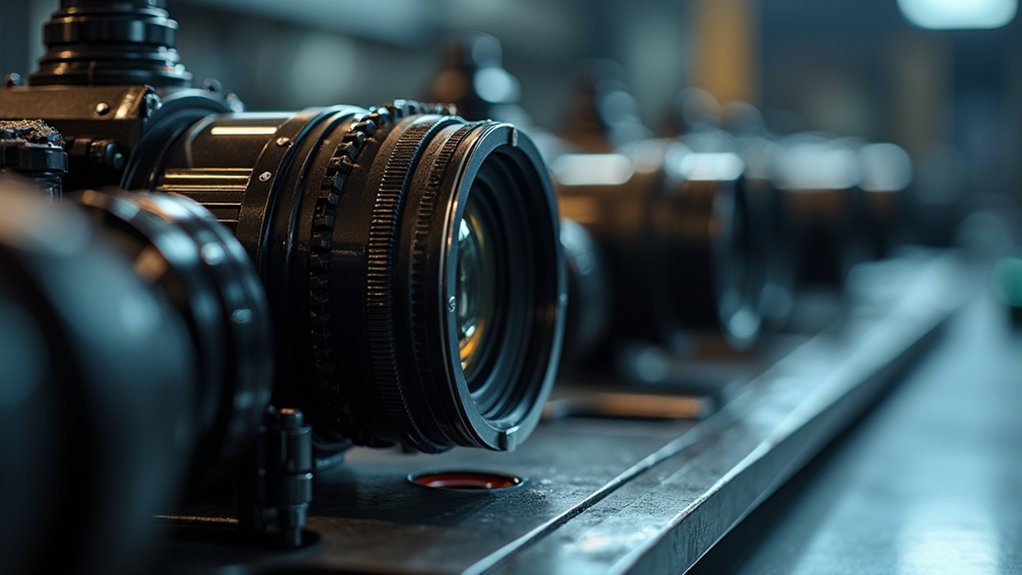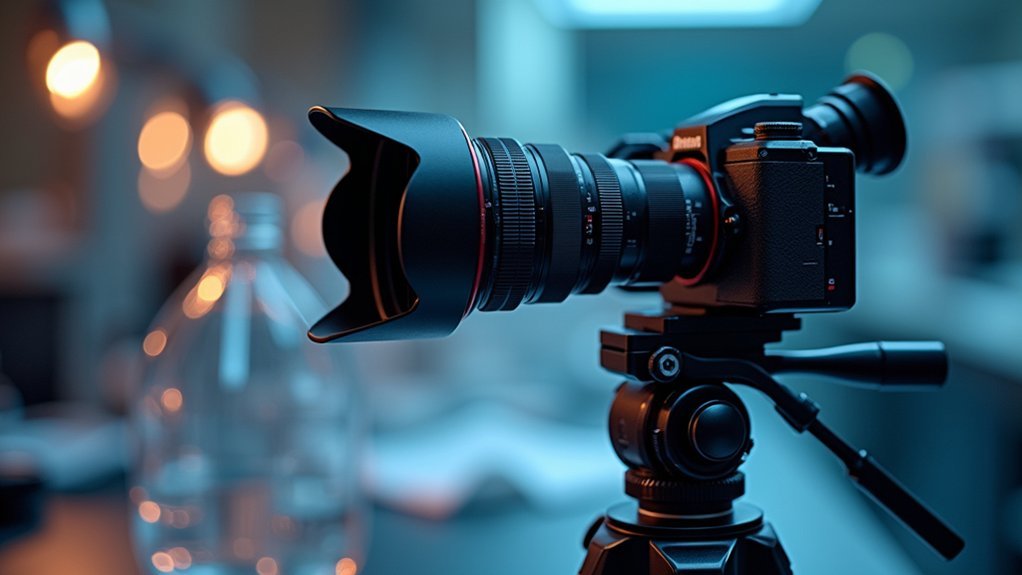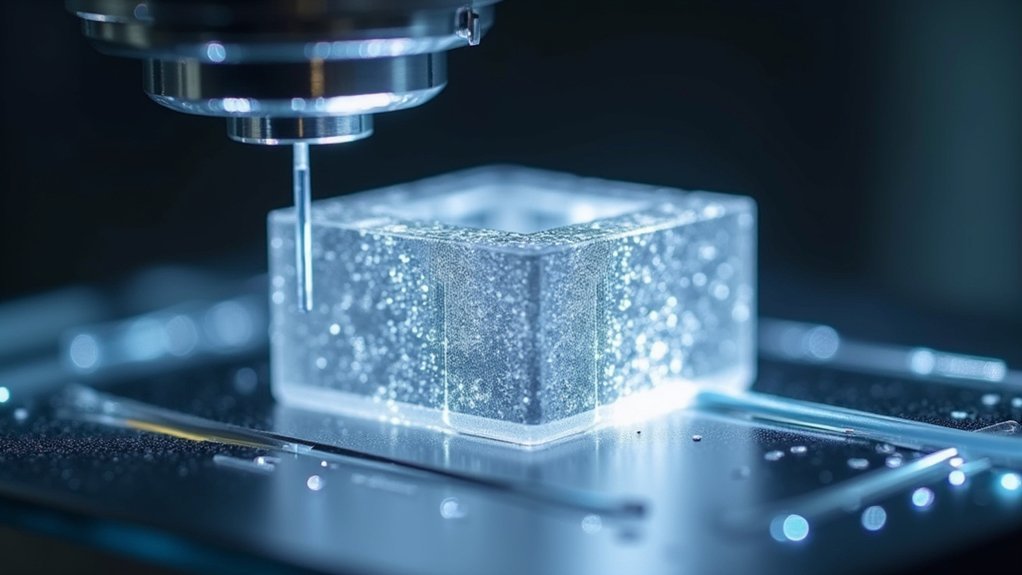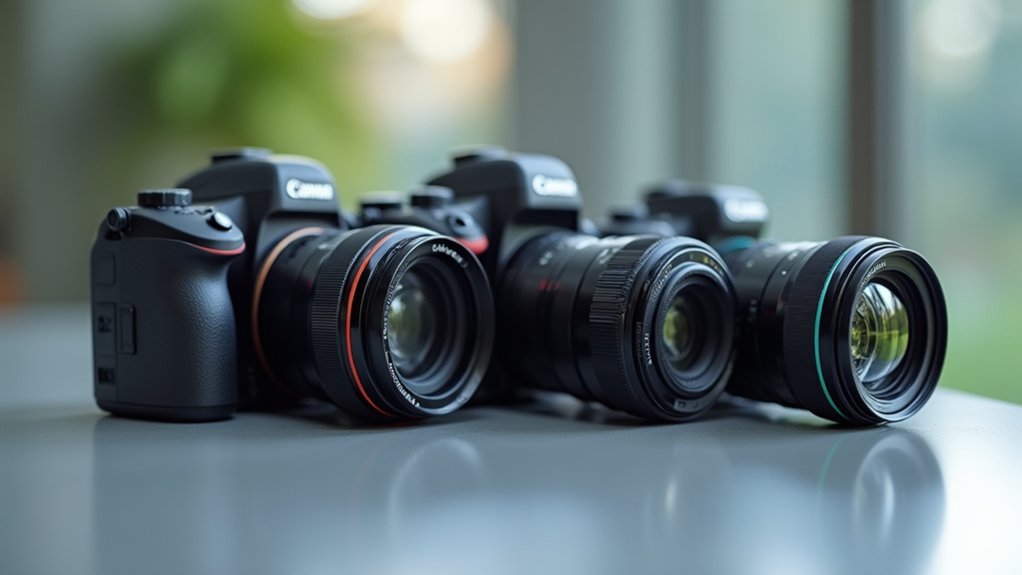Five camera coupling methods for clear scientific photos include lens coupling systems that maximize signal-to-noise ratio, fiber optic tapers offering exceptional light transfer efficiency, direct CMOS integration for high-speed imaging, global shutter technology that eliminates motion artifacts, and scintillator-based coupling for enhanced electron microscopy. You’ll find each method offers specific advantages depending on your imaging needs—from preserving optical resolution to capturing dynamic processes with precision. Explore these technologies to transform your scientific imaging capabilities.
Lens Coupling Systems: Maximizing Signal-to-Noise Ratio

While various camera coupling methods exist, lens coupling systems stand out by utilizing multiple lenses to image the phosphor screen onto the CCD sensor with exceptional precision.
With an impressive F/0.8 specification, these systems achieve coupling efficiency approaching 100%, ensuring virtually all photons reach your CCD sensor.
Maximum photon capture at F/0.8 delivers near-perfect efficiency, ensuring optimal sensor utilization for superior imaging results.
You’ll appreciate how lens coupling preserves optical resolution while avoiding distortion and honeycomb patterns common in alternative methods. This technology maximizes signal-to-noise ratio, delivering superior image quality even under challenging conditions.
Unlike fiber optic coupling, lens systems offer greater adaptability, making component replacement simpler and allowing optimization across different camera setups.
The enhanced frame exposure mode further reduces read noise, giving you high resolution imaging capabilities even in low-dose scenarios where subtle features might otherwise be lost.
Fiber Optic Tapers: Achieving Optimal Light Transfer Efficiency
Fiber optic tapers represent an alternative approach to camera coupling that offers remarkable light transfer capabilities. Unlike optical lens systems, these coherent fiber bundles can increase collection efficiency up to 16 times when using a 2:1 demagnification ratio, dramatically improving your imaging system’s performance.
When you directly bond a fiber coupling to a CCD sensor, you’ll minimize transmission losses while preserving spatial resolution. This is particularly valuable when working with scintillator screens in x-ray applications. The consistent fiber-to-CCD distance is critical, as any variation affects light emergence and image data quality.
For high dynamic range applications, back-illuminated CCDs paired with precisely bonded fiber bundles deliver superior results.
Current research focuses on expanding taper diameter limits and developing enhanced bonding techniques that maintain efficiency even in challenging low-temperature environments.
Direct CMOS Integration: High-Speed Imaging Solutions

Unlike traditional coupling methods, direct CMOS integration represents a breakthrough in high-speed scientific imaging. You’ll achieve unprecedented performance with 4k x 4k image capture at 50 fps, perfect for dynamic observations in your research.
| Feature | Specification | Benefit | Application |
|---|---|---|---|
| Resolution | 19M pixels | Enhanced detail | Material analysis |
| Frame Rate | Up to 1,600 fps | Real-time capture | Biological samples |
| Sensor Type | Always-on HDR CMOS | Ideal SNR | Low-dose conditions |
| Software | User-friendly interface | Easy parameter control | Multiple techniques |
This camera system delivers exceptional clarity even under challenging conditions. The low-noise CMOS sensor reveals subtle diffraction features while maintaining high frame rates at various resolutions. You’ll appreciate the streamlined workflow that lets you focus on research rather than equipment settings.
Global Shutter Technology: Eliminating Motion Artifacts
When capturing rapidly moving subjects, global shutter technology offers a substantial advantage over conventional systems. Unlike rolling shutters that expose pixels sequentially and create skewed or distorted images, global shutters capture all pixels simultaneously, completely eliminating motion artifacts.
You’ll notice improved image integrity in high-speed imaging applications, with crystal-clear captures at up to 58 fps in full pixel mode. This technology prevents the time delays associated with sequential exposure, delivering sharper representations of dynamic subjects.
Global shutter technology also enhances your low-light performance by minimizing blur and preserving detail—particularly valuable in low-dose electron microscopy.
For scientific imaging where precision and clarity are essential, this technology’s ability to reduce artifacts during dynamic observations makes it an indispensable tool in your imaging arsenal.
Scintillator-Based Coupling: Enhancing Electron Microscopy Images

The extraordinary capabilities of scintillator-based coupling systems have revolutionized electron microscopy imaging. When you’re working with transmission electron microscopy, phosphor screens convert high-energy electrons into visible light, dramatically improving your ability to capture fine details.
The F/0.8 coupling lens offers superior efficiency compared to fiber optic couplings, which suffer from light transmission losses and reduced image quality.
The F/0.8 coupling lens delivers unmatched efficiency, eliminating the transmission losses that plague fiber optic systems.
You’ll notice a significant enhancement in signal-to-noise ratio when using scintillator cameras with CMOS sensors, allowing you to resolve subtle features in low-contrast imaging scenarios.
This technology enables you to capture high-resolution images at impressive frame rates up to 1,600 fps, which is particularly valuable for analyzing materials under low-dose conditions where every photon counts.
Frequently Asked Questions
How Do Temperature Fluctuations Affect Camera Coupling Performance?
Temperature fluctuations cause expansion and contraction in coupling materials, affecting alignment precision. You’ll notice degraded image quality when thermal changes loosen connections or create subtle misalignments between your camera and instrument.
Can Coupling Methods Be Optimized for Infrared Imaging Applications?
Yes, you can optimize coupling methods for infrared imaging by using specialized IR-transparent materials, adjusting mount tolerances for thermal expansion, and implementing active cooling systems to minimize heat-related distortions during long exposures.
What Maintenance Routines Extend the Lifespan of Coupled Camera Systems?
You’ll extend your coupled camera system’s lifespan by regularly cleaning optical surfaces, checking mechanical alignments, replacing worn gaskets, storing in dry environments, and performing calibration checks. Don’t forget to update firmware when available.
How Do Vibration Isolation Techniques Impact Coupling Efficiency?
Vibration isolation techniques greatly improve your coupling efficiency by preventing motion blur. You’ll achieve better light transmission as vibrations won’t disrupt the precise alignment between your optical components, resulting in sharper, more consistent imaging results.
Are There Waterproof Coupling Solutions for Underwater Scientific Photography?
Yes, you’ll find specialized underwater couplings with O-ring seals, waterproof housings, and vacuum ports that maintain optical connectivity while preventing water intrusion. They’re designed specifically for marine biology and oceanographic research applications.
In Summary
You’ve now explored five critical camera coupling methods that can transform your scientific imaging. By selecting the appropriate technique—whether it’s lens systems for SNR improvement, fiber optic tapers for efficient light transfer, direct CMOS for speed, global shutter technology for motion clarity, or scintillator coupling for electron microscopy—you’ll capture clearer, more accurate images. Choose the right coupling method for your specific research needs to achieve ideal scientific visualization results.





Leave a Reply